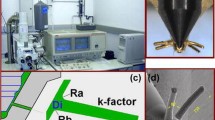Abstract
The impact of diameter and shape changes of diesel injector nozzles on the internal flow and spray behavior is numerically investigated and compared to the experimental data obtained with new nozzle designs. The diameter was varied between 70 and 130 µm and the number of nozzle holes increased from 8 to 14. Furthermore, new nozzle hole concepts were investigated which feature different diameters in one hole circle (6 + 6 hole nozzle). A diameter ratio of 1.3 and of 2 was applied. The reduction in the spray hole diameter led to a reduction in the mass flow of the nozzle and to a diminished spray penetration. Using the 6 + 6 hole nozzle with a ratio of 1.3, very similar penetration depths were seen for both injection holes despite the different diameter. An increase of the diameter ratio or a design change of the smaller nozzles leads to the desired effect that the spray of the smaller nozzles shows significant smaller penetration depths than the one of the bigger holes.


















Similar content being viewed by others
Abbreviations
- C D :
-
Discharge coefficient (−)
- ṁ :
-
Mass flow (kg/s)
- N p :
-
Number of phases (−)
- p :
-
Pressure (N/m²)
- r :
-
Volume fraction (−)
- ρ :
-
Density (kg/m³)
- R B :
-
Radius of cavitation bubble (m)
- S :
-
Penetration length (m)
- S ϕ :
-
Source term (−)
- t :
-
Time (s)
- \(\overset{\lower0.5em\hbox{$\smash{\scriptscriptstyle\rightharpoonup}$}} {v}\) :
-
Velocity vector (m/s)
- Γ :
-
Diffusivity (kg/ms)
- σ :
-
Surface tension (N/m)
- Φ :
-
Transported quantity (−)
References
Rollbusch, C.: Effects of hydraulic nozzle flow rate and high injection pressure on mixture formation, combustion and emissions on a single-cylinder DI light-duty diesel engine. Int. J. Engine Res. 13(4), 323–339 (2012). https://doi.org/10.1177/1468087411430304
Nishida, K., Gao, J., Manabe, T., Zhang, Y.: Spray and mixture properties of evaporating fuel spray injected by hole-type direct injection diesel injector. Int. J. Engine Res. 9(4), 347–360 (2008). https://doi.org/10.1243/14680874JER00508
Gao, J., Matsumoto, Y., Namba, M., Nishida, K.: Group-Hole Nozzle Effects on Mixture Formation and In-cylinder Combustion Processes in Direct-Injection Diesel Engines. SAE Technical Paper 2007-01-4050 (2007). https://doi.org/10.4271/2007-01-4050
Gao, J., Matsumoto, Y., Namba, M., Nishida, K.: An investigation of mixture formation and in-cylinder combustion processes in direct injection diesel engines using group-hole nozzles. Int. J. Engine Res. 10(1), 27–44 (2009). https://doi.org/10.1243/14680874JER02108
Payri, R., Salvador, F.J., Gimeno, J., Novella, R.: Flow regime effects on non-cavitating injection nozzles over spray behavior. Int. J. Heat Fluid Flow. 32(1), 273–284 (2011). https://doi.org/10.1016/j.ijheatfluidflow.2010.10.001
Zhu, J., Kuti, O.A., Nishida, K.: An investigation of the effects of fuel injection pressure, ambient gas density and nozzle hole diameter on surrounding gas flow of a single diesel spray by the laser-induced fluorescence-particle image velocimetry technique. Int. J. Engine Res. 14(6), 630–645 (2013). https://doi.org/10.1177/1468087412458778
Payri, F., Bermúdez, V., Payri, R., Salvador, F.J.: The influence of cavitation on the internal flow and the spray characteristics in diesel injection nozzles. Fuel. 83(4–5), 419–431 (2004). https://doi.org/10.1016/j.fuel.2003.09.010
Som, S., Ramirez, A.I., Longman, D.E., Aggarwal, S.K.: Effect of nozzle orifice geometry on spray, combustion, and emission characteristics under diesel engine conditions. Fuel. 90(3), 1267–1276 (2011). https://doi.org/10.1016/j.fuel.2010.10.048
Sun, Z.Y., Li, G.X., Chen, C., Yu, Y.S., Gao, G.X.: Numerical investigation on effects of nozzle’s geometric parameters on the flow and the cavitation characteristics within injector’s nozzle for a high-pressure common-rail DI diesel engine. Energy Convers. Manag. 89, 843–861 (2015). https://doi.org/10.1016/j.enconman.2014.10.047
Winter, J., Dittus, B., Kerst, A., Muck, O., Schulz, R., Vogel, A.: Nozzle hole geometry—a powerful instrument for advanced spray design. In: THIESEL International Conference on Thermo-and fluid dynamic processes in diesel engines, Valencia, Spain (2004)
Hielscher, K., Brauer, M., Baar, R.: Effects of new nozzle hole configurations on air utilization and soot emissions of diesel engines.. In: 16. Internationales Stuttgarter Symposium: Automobil- und Motorentechnik. Springer Fachmedien Wiesbaden, Wiesbadenl (2016)
Som, S., Ramirez, A., Aggarwal, S., Kastengren, A. et al.: Development and Validation of a Primary Breakup Model for Diesel Engine Applications. SAE Technical Paper 2009-01-0838 (2009). https://doi.org/10.4271/2009-01-0838
von Berg, E., Edelbauer, W., Alajbegovic, A., Tatschl, R., Volmajer, M., Kegl, B., Ganippa, L.C.: Coupled simulations of nozzle flow, primary fuel jet breakup, and spray formation. J. Eng. Gas Turbines Power. 127(4), 897 (2005). https://doi.org/10.1115/1.1914803
Soriano Palao, J.O.: Modellierung des Einflusses der Düsenströmung auf den Zerfall von Dieselstrahlen. Dissertation. Martin-Luther-Universität, Halle-Wittenberg (2009)
Suzzi, D.: Diesel Nozzle Flow and Spray Formation: Coupled Simulations with Real Engine Validation. Dissertation. Universität Stuttgart, Stuttgart (2009)
Ansys Inc: ANSYS CFX-Solver Theory Guide (2013). http://148.204.81.206/Ansys/150/ANSYS%20CFX-Solver%20Theory%20Guide.pdf
Bakir, F., Rey, R., Gerber, A., Belamri, T., Hutchinson, B.: Numerical and experimental investigations of the cavitating behavior of an inducer. Int. J. Rotat. Mach. 10(1), 15–25 (2004). https://doi.org/10.1080/10236210490258034
Tanner, F.: Liquid Jet Atomization and Droplet Breakup Modeling of Non-Evaporating Diesel Fuel Sprays. SAE Technical Paper 970050 (1997). https://doi.org/10.4271/970050
Tanner, F.: A Cascade Atomization and Drop Breakup Model for the Simulation of High-Pressure Liquid Jets. SAE Technical Paper 2003-01-1044 (2003). https://doi.org/10.4271/2003-01-1044
Wu, K.-J., Reitz, R.D., Bracco, F.V.: Measurements of drop size at the spray edge near the nozzle in atomizing liquid jets. Phys. Fluids. 29(4), 941 (1986). https://doi.org/10.1063/1.865689
Reitz, R.D.: Atomization and other breakup regimes of a liquid jet. Dissertation. Princeton University, Princeton (1978)
Naber, J. and Siebers, D.: Effects of Gas Density and Vaporization on Penetration and Dispersion of Diesel Sprays. SAE Technical Paper 960034 (1996). https://doi.org/10.4271/960034
Author information
Authors and Affiliations
Corresponding author
Rights and permissions
About this article
Cite this article
Vasconi, C., Baar, R. Numerical and experimental investigations of new nozzle concepts for diesel injectors. Automot. Engine Technol. 3, 29–44 (2018). https://doi.org/10.1007/s41104-018-0025-0
Received:
Accepted:
Published:
Issue Date:
DOI: https://doi.org/10.1007/s41104-018-0025-0




